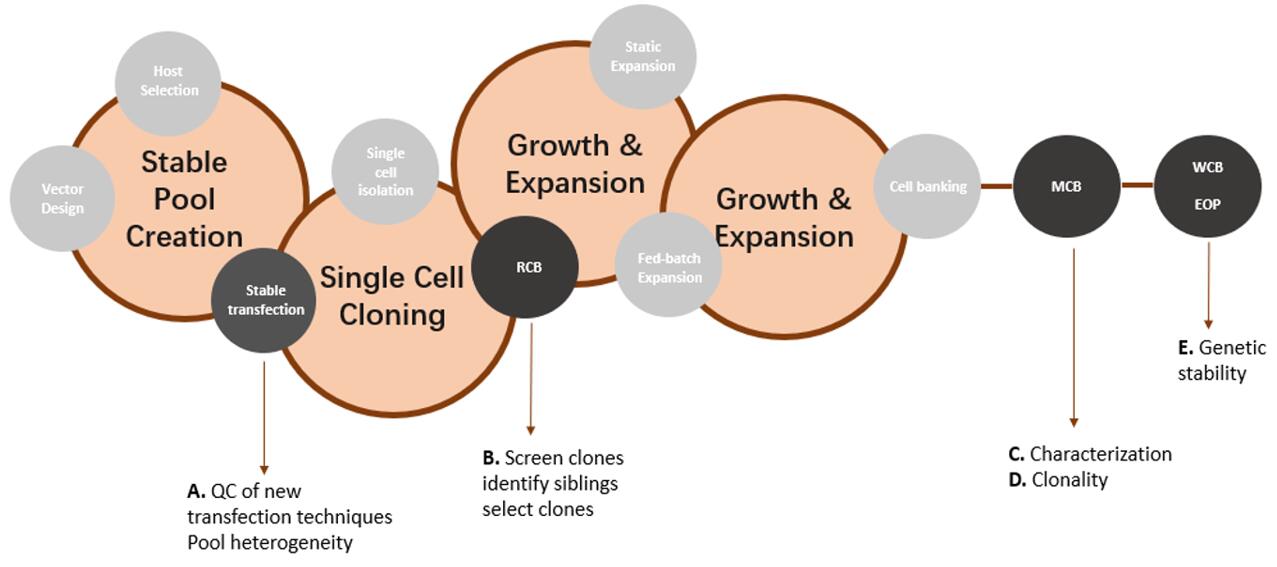ST Cell Line Transgene Integrations QC & Copy Number (Locus Amplification & Sequencing)
ST cells are one of cell lines most suitable for producing vaccines against pseudorabies virus. According to ICH Q5B and Q5D guidelines, regulating agencies request that cell substrates must be analyzed at two time points (i.e., on the level of the Master Cell Bank and on the level of the End of Production cells) to show their genetic stability. Typical assays include those intended to confirm the integrity of the product transcript, the genome structure at integration site, and the ratio of insert gene copy number.
Creative Bioarray has developed the Transgene Mapping (Locus Amplification & Sequencing) analysis, which is a powerful tool to sequence transgenes and their integration sites.
 Figure 1: Overview of different stages of cell line development (in circles) and the purpose of Transgene Mapping (Locus Amplification & Sequencing) analyses (A-E).
Figure 1: Overview of different stages of cell line development (in circles) and the purpose of Transgene Mapping (Locus Amplification & Sequencing) analyses (A-E).
Transgene Mapping (Locus Amplification & Sequencing) analysis method is a powerful technology for profiling the genetic makeup of various biological samples, including ST industrial production cell lines. Here are some of the key advantages:
- Comprehensive Coverage: Transgene Mapping (Locus Amplification & Sequencing) analysis allows for complete and uniform coverage of genes, including the exons, introns, promoter regions, and enhancer sequences. This means it provides a more detailed view of the genetic variation involving these regions.
- High Resolution: Transgene Mapping (Locus Amplification & Sequencing) analysis can detect both single nucleotide variants (SNVs) and larger structural variants (SVs), which can be critical for understanding the function and regulation of specific genes.
- High Sensitivity: Transgene Mapping (Locus Amplification & Sequencing) analysis is highly sensitive and can detect low-frequency variants that might be missed by other sequencing methods.
- Detects Unforeseen Mutations: This method detects mutations that fall outside of targeted panels; it also detects copy number variations (CNVs) and can identify the integration sites of vectors used in the genetic modification of the cells.
- Versatility: It is applicable to a variety of biological samples, including formalin-fixed, paraffin-embedded (FFPE) tissues, cultured cells, fresh and frozen tissues, and even circulating free DNA in plasma or serum.
- Easy to use: Transgene Mapping (Locus Amplification & Sequencing) analysis is easy to set up in a lab and does not require specialized equipment.
ST Cell Line Transgene Integrations QC & Copy Number (Locus Amplification & Sequencing) analysis can:
- Identify the transgene integration site(s)
- Detect structural changes in the host DNA at the transgene integration site(s)
- Sequence the entire transgene and detect any sequence variants as well as structural changes within the transgene
- Provide an estimation of the transgene copy number
ST Cell Line Transgene Integrations QC & Copy Number (Locus Amplification & Sequencing) Features:
- Genetic stability analysis across various generations (e.g., MCB, WCB, EOP)
- In accordance with ICH Q5B and Q5D guidelines
- Final conclusions on stability of analyzed cell bank(s)
- Reporting meeting regulatory requirements
- Pre-finalization report review included
- Fast turnaround time
Quotation and ordering
Our customer service representatives are available 24hr a day! We thank you for considering Creative Bioarray as your ST Cell Line Transgene Integrations QC & Copy Number (Locus Amplification & Sequencing) partner.
All products and services on this website are only suitable for non-medical purposes.


 Figure 1: Overview of different stages of cell line development (in circles) and the purpose of Transgene Mapping (Locus Amplification & Sequencing) analyses (A-E).
Figure 1: Overview of different stages of cell line development (in circles) and the purpose of Transgene Mapping (Locus Amplification & Sequencing) analyses (A-E).



